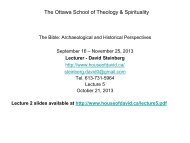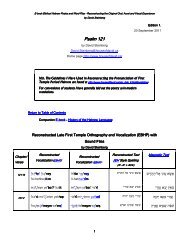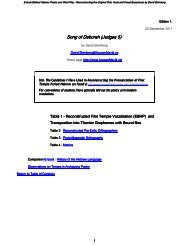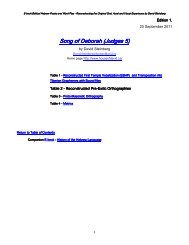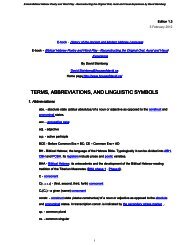Biblical Hebrew Poetry - House of David Steinberg
Biblical Hebrew Poetry - House of David Steinberg
Biblical Hebrew Poetry - House of David Steinberg
You also want an ePaper? Increase the reach of your titles
YUMPU automatically turns print PDFs into web optimized ePapers that Google loves.
10<br />
E-book<br />
<strong>Biblical</strong> <strong>Hebrew</strong> <strong>Poetry</strong> and Word Play - Reconstructing the Original Oral, Aural and Visual Experience by <strong>David</strong> <strong>Steinberg</strong><br />
1. <strong>Biblical</strong> Skeleton, Changing Script and Orthography, Medieval Vowel Signs, Modern<br />
Pronunciation<br />
Box 4<br />
The Three Orthographic<br />
Elements in the Masoretic Text<br />
"Of the three distinct orthographic elements in the MT. the consonantal text (including<br />
graphemes for consonants which quiesced in the course <strong>of</strong> time), the m.l., and the vowel<br />
points, the third was the last to he added to the text. While the first two elements were<br />
certainly combined by the 3rd century B.C.E., as evidenced by the proto-Massoretic text<br />
types found at Qumran 13 ,- the vowel points were not added before the 6th century C.E. 14 The<br />
relative lateness <strong>of</strong> these signs does not indicate that the tradition <strong>of</strong> pronunciation which<br />
they were intended to record and preserve originated in the period <strong>of</strong> the Massoretes<br />
themselves. The text without vowel signs was read orally long before the diacritical marks<br />
were invented to indicate vowels. The vowel signs were intended to guide readers in the<br />
correct pronunciation <strong>of</strong> the words according to traditions known to the different schools <strong>of</strong><br />
Massoretes. As A. Dotan indicates (Masorah, cols 1401-82, Encyclopedia Judaica, vol. 16,<br />
Keter, Jerusalem, 1971: ref. is to col. 1409) 15 :<br />
… the notes concerning the text <strong>of</strong> the Bible and the instructions for its proper pronunciation and its exact<br />
copying w ere handed dow n orally from generation to generation before they were set down in writing. It may be<br />
assumed that these comments could be written down and were committed to writing ... apparently in the sixth or seventh<br />
century C.E. Therefore, one must differentiate quite clearly between the oral Masorah which is endless and cannot be defined<br />
even though there are allusions to it and evidence there<strong>of</strong>, and between the written Masorah whose notations were<br />
written in the margins <strong>of</strong> the codices and which is simply called "the Masorah."<br />
This <strong>of</strong> course does not imply that the massoretic traditions accurately reflect the manner in<br />
which these texts were pronounced by their authors. Nevertheless, the traditions do reflect an<br />
archaic phonology. Investigations <strong>of</strong> Qumranic and Mishnaic <strong>Hebrew</strong> (ca. 50 B.C.E.-200 C.E.)<br />
indicate that postbiblical <strong>Hebrew</strong> phonology was different than that <strong>of</strong> biblical <strong>Hebrew</strong>; e.g.,<br />
the laryngeals ’ and h and the pharyngeals c and ḥ became weakened (Kutscher 1974: 505-7;<br />
1971: cols. 1586, 1595-96). Massoretic vocalisation indicates that these were not weakened<br />
or leveled in the reading tradition, but that they were preserved (Kutscher 1974: 510-11)."<br />
Quoted from Zevit 1980, p. 9.<br />
See also Did the Tiberian Masoretes Simply Encode Tradition <strong>of</strong> Did they "Do Grammar"



